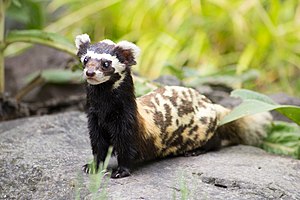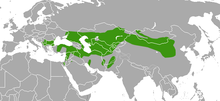Tigeriltis
| Tigeriltis | ||||||||||||
|---|---|---|---|---|---|---|---|---|---|---|---|---|

Tigeriltis ( Vormela peregusna ) |
||||||||||||
| Systematics | ||||||||||||
|
||||||||||||
| Scientific name of the genus | ||||||||||||
| Vormela | ||||||||||||
| Blasius , 1884 | ||||||||||||
| Scientific name of the species | ||||||||||||
| Vormela peregusna | ||||||||||||
| ( Güldenstädt , 1770) |
The tigeriltis ( Vormela peregusna ) is a species of predator from the marten family (Mustelidae). It lives in Eastern Europe , Middle East and Central Asia and is named for its patterned fur.
features

The shape of the tiger iltis is very similar to the forest and steppe iltis , but with a head-to-trunk length of 29 to 38 centimeters and a tail length of approximately 15 to 22 centimeters, it is somewhat smaller than these. Fully grown Tiger Tissues weigh between 370 and 730 grams. In contrast to many other related species, males and females are approximately the same size. In his physique he shows with the elongated, narrow trunk and the short legs the usual physique of many Mustelinae . The upper side has a dark brown basic color, which is covered with yellow spots and stripes. The ventral side is black. Tigers have a striking black and white facial coloring: the area around the mouth and a wide headband between the eyes and ears are white, the rest of the face is black. The ears are unusually large. The tail is bushy and has a black tip.
distribution and habitat
The animals are common in Eastern Europe and Asia . The distribution area extends from the Balkan Peninsula and the Middle East (excluding the Arabian Peninsula ) through southern Russia to Pakistan . There are also isolated occurrences in the Russian- Kazakh border area and in the Sino - Mongolian border area.
Tiger turtles inhabit dry, treeless areas such as steppes, semi-deserts and deserts, and occasionally grassy areas in foothills. The animals have also been observed very rarely in mountains, where they have been detected at altitudes of up to 3000 meters. In the meantime, some animals also live in parks, vineyards and even housing developments.
Way of life
The way of life of the tiger elk is very similar to that of the steppe elk . They are primarily crepuscular or nocturnal, but sometimes go looking for food during the day. They usually spend the day in an earthworks that they have either dug themselves or taken over from other animals. Outside of the mating season, they live solitary. The territories can overlap, but the animals usually avoid each other.
When threatened, it straightens its body hair and bends its bushy tail forward; the warning signal color is intended to deter predators , similar to that of the Skunks . If this doesn't help, he can spray a foul-smelling secretion from his anal gland .
food
Tiger turtles hunt both on the surface of the earth, where they sometimes stand up to have a better overview, and on trees that they climb. Most often, however, they go hunting in the underground passages and burrows of various rodents, sometimes they also settle down directly in the burrows. Their main diet includes gerbils , voles , ground squirrels and other ground squirrels or hamsters , but they also eat birds and other vertebrates and insects .
Reproduction
Mating takes place between March and June. The gestation period of the Tigeriltisse usually lasts 45 days. However, it can extend to up to eleven months, which is due to the dormancy and the associated delayed implantation. The environmental conditions, especially the temperature, have an influence on the gestation period. Favorable environmental conditions mean a short gestation period.
The females give birth to one to eight (four or five on average) young per litter. These are small and blind, but they grow quickly and start to eat solid foods after a month. Females become sexually mature after three months, while males take up to a year.
Little is known about life expectancy. An animal in human care lived to be almost nine years old.
Systematics

Six subspecies are distinguished:
- Vormela peregusna peregusna : The nominate form lives in southern Russia , southern Ukraine and the northern Caucasus .
- Vormela peregusna euxina : The European subspecies is distributed from Croatia via Bosnia-Herzegovina and Serbia to Romania and Bulgaria ; also in Moldova , south-west Ukraine and north-west Turkey .
- Vormela peregusna syriaca : Israel , Lebanon , Jordan , Syria , eastern Turkey, southern Caucasus, northern Iraq , northwestern Iran .
- Vormela peregusna alpherakyi : Western Kazakhstan , Uzbekistan , Turkmenistan , northern Iran, Afghanistan , Pakistan .
- Vormela peregusna pallidor : The first of the two isolated subspecies lives in Omsk Oblast .
- Vormela peregusna negans : This subspecies is also isolated from the others and lives in the eastern part of the border area between Mongolia and Inner Mongolia .
Surname
Both genus and species names are not Latin in origin. The generic name Vormela is formed from the German Wormlein (old for little worm ). The species name peregusna is derived from pereguznya , a Ukrainian name for the Tigeriltiss.
Danger
In the 20th century, the stocks declined rapidly in some cases. The hunt for their fur, which plays a subordinate role in comparison to other martens, is less responsible for this (fur name: Perwitzky ). Rather, the main threat is the conversion of their habitat into agricultural areas. Further deaths occur from road traffic, poisoning from rat poison or because they fall into traps intended for other animals. The species is currently designated as vulnerable in the Red List of Endangered Species of the International Union for Conservation of Nature ( IUCN ), after it was not considered endangered in 1996.
The relationship between humans and Tigeriltis
Wherever tiger turtles are found near humans, they can invade chicken coops or even steal food supplies from huts. Most of the time, however, they are considered useful because their main prey is rodents. In Afghanistan, they are sometimes kept semi-tame and used to fight rats and mice.
An old Russian legend is associated with the Tigeriltis. In the vernacular, the animal is also called perewostschik ("ferryman"). According to Siberian tradition, he carries squirrels and ermines as a ferryman on his back across the great Siberian rivers.
swell
Individual evidence
- ↑ Vormela peregusna in the endangered Red List species the IUCN 2012. Posted by: A. Tikhonov and others, 2008. Accessed on March 25, 2013 ..
- ^ Fritz Schmidt : The book of the fur animals and fur, 1970, FC Mayer Verlag, Munich
literature
- Ronald M. Nowak: Walker's Mammals of the World . Johns Hopkins University Press, 1999 ISBN 0-8018-5789-9
- Wanda A. Gorsuch, Serge Larivière: Vormela peregusna . Mammalian Species No. 779, 2005.
